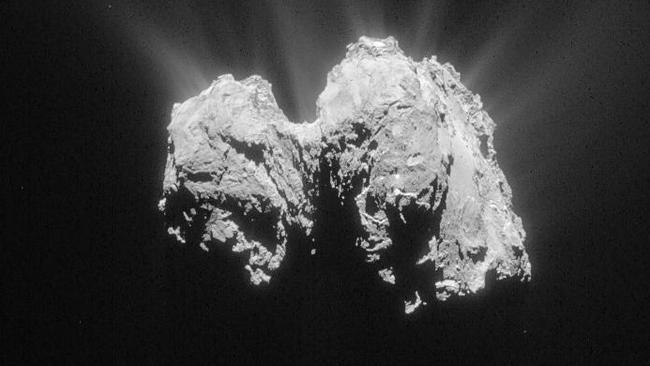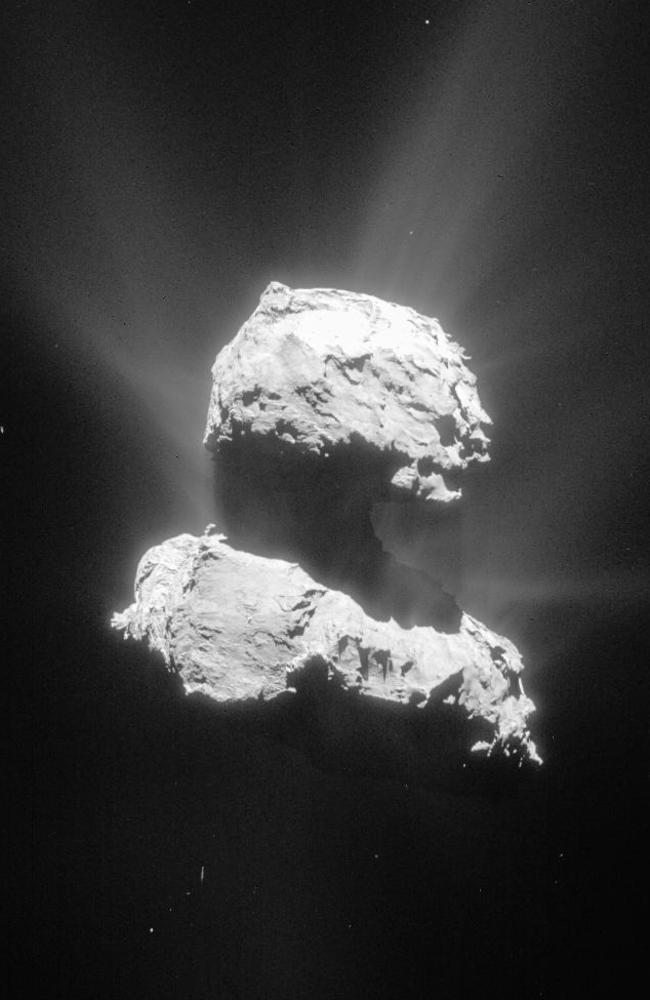Pictures from the Rosetta space probe’s close encounter with Comet 67P released
THIS heavenly body’s beauty is incredible — in a stark, primordial kind of way. The eerie landscape of Comet 67P is unlike anything we’ve seen before.

THIS heavenly body’s beauty is incredible — in a stark, primordial kind of way. The eerie landscape of Comet 67P is unlike anything we’ve seen before.
It’s jagged. It’s smooth. It’s a random jumble of rock and shards of ice.
TOUR COMET 67P: Browse Rosetta’s image archive
A stock of new images beamed back from the Rosetta space probe’s close encounter with comet 67P/ Churyumov-Gerasimenko — and we’re talking 7.9km close — have been released. They reveal a place you probably wouldn’t want to visit ... and really wouldn’t want to call home..
Just released: 1776 NavCam images from 10km orbit & #CometLanding! Enjoy! http://t.co/qv7OLtJgdC pic.twitter.com/4z9SR5LM1g
— ESA Rosetta Mission (@ESA_Rosetta) May 28, 2015The blasted alien landscape reveals the raw energy of space. It’s a 4km wide mash of ice shards, snow flakes, pebbles and boulders.
It’s an eerie, dead place.
And no two places are the same.

There are 900m high cliffs, and flat dunes of drifting powdered ice. Rubble is strewn everywhere.
Everything about the comet is primordial: From its age to the way none of its edges have been smoothed by time and weathering.
#ICYMI Latest NAVCAM release includes images of #67P from #CometLanding: http://t.co/xoRqYJYSmW pic.twitter.com/GYypwGDQEj
— ESA Rosetta Mission (@ESA_Rosetta) May 29, 2015Comet 67P’s unusual “rubber-duck” shape is believed to be the result of an ancient collision between two large piles of rubble out in the distant Oort cloud surrounding our solar system. It may have been that collision which sent it spiralling down towards the sun.

Many of its geological features are unexpected: In particular the “goose bumps” scattered through the walls of cliffs. Most seem to be about 3m in diameter, and nobody yet has any idea how they formed.

The probe has been busily analysing the chemical processes involved in the creation of comet tails. It’s already shown how photons from the sun collide with water and carbon dioxide molecules, ionising them and causing them to clash with other water and carbon dioxide molecules — and propelling them out into space.
New result! Close study of #67P reveals how water & carbon dioxide molecules are broken up: http://t.co/sZHPp3I8uI pic.twitter.com/fnhwQCkC7E
— ESA Rosetta Mission (@ESA_Rosetta) June 2, 2015While contact with Rosetta’s lost lander, Philae, has not yet been regained, officials maintain there is still some hope the fridge-sized lander will get enough sun to warm up and reboot its computer systems.
However, the last act of the intrepid space probe Rosetta will be to attempt a landing next to its lost companion.

The mission, which is likely to run into early next year, will wrap up by using the last of the probe’s fuel to set it down next to the lander “for emotional reasons”.
“The best thing to do is to get as close to the comet and then let it join Philae on the surface next year. Mother and child reunited,” Project scientist Matt Taylor told The Telegraph.
RT @esa: VID: @ESA_Rosetta 's adventure so far and what we have learned about comets https://t.co/rm4CagoURO
— ESA Rosetta Mission (@ESA_Rosetta) May 26, 2015



